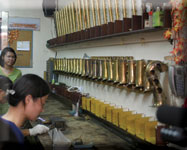| |

|
Manufacturing
Process |
|
| |
|
|
| |
A
saxophone is manufactured by combining two main parts: accessories
and main body: |
|
| |
|
|
| |
| 1.
Accessories |
| The
fabrications of accessories such as key column, buttons, and
keys consist of precise machining and painting of these parts.
A standard saxophone has twenty five tone holes, which means
there is a large number of accessories, such as keys, key
column, reed, spring-loaded steel pin, buttons, cork, and
so on. |
| 2.
Tube |
| The
tube consists of a bell-shaped tube, mouthpiece, neck, and
U-shaped tube. These pieces were welded, hammered, polished,
finished, and fine-tuned to produce a saxophone. The exterior
of the saxophone is polished to a brilliant shine, as if it
has been plated with gold. |
|
|
| |
|
|
| |
| It
takes about one month to make a saxophone. The accuracy of
musical notes is dependent on the main tube. Since the main
tube has several tone holes to produce the various notes,
it is crucial to make sure these tone holes were made to the
exact specification. Other factors are the reed and the spring-loaded
steel pin, which can all affect the worthiness of the saxophone.
|
 The
manufacturing of a saxophone
The
manufacturing of a saxophone |
|
|
| |
|
|
| |
It
has been said that the famous French brand Selmer utilizes the whale's
skin to make the reed for its saxophones. Their reasoning was that
the whale's skin has superior strength due to an environment of
high pressure and corrosive elements. In addition, the spring-loaded
steel pin in the Selmer brand saxophone has always been more sensitive
than other brands. However, the composition of the steel pin is
still a commercial secret. |
|
| |
|
|
| |
Manufacturing
Flowchart |
Material |
Accessories
Fabrication |
Main
Tube Fabrication |
Key
Column |
Buttons |
Key |
Bell
Tube |
Mouth
Piece |
Middle
Tube |
Curved
Tube |
Trimming |
Polishing |
Finishing
|
Quality
Assurance |
Painting
|
Electro-Plated |
Assembly |
Cost
Analysis |
Packaging |
Go
into Stock |
|
|
| |
|
|
| |
|
|
| |
|
|
| |
| |
|
 |





